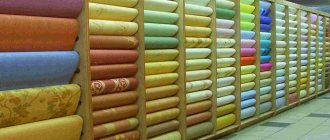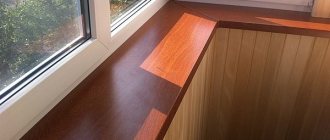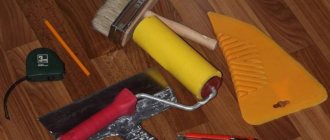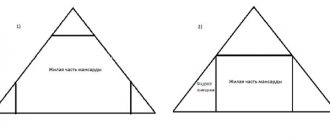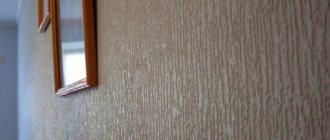Blinds are a universal means of protection from the sun's rays in the early morning or on bright summer evenings. Sometimes there is simply no opportunity to purchase curtains, and making them yourself requires a lot of effort.
This is where blinds will help you out. You can buy them in a store at a lower price or make them yourself using a roll of wallpaper and other scrap materials. Our detailed photo and video instructions, which describe the entire process step by step, will also come to your aid.
Handmade products have always been famous for their quality and originality. Manual labor is valued much higher than refined innovative technologies. Without much effort, you can make your own blinds in your favorite colors, adding variety to the room. Such curtains look creative and will not go unnoticed by your guests.
Wallpaper blinds have certain advantages over alternative options:
- availability, low price. All you need is paper wallpaper, strings, tapes and tools available in every home;
- fire safety;
- ease of manufacture;
- the ability to combine with other curtains, blinds. You choose the required color yourself, decorate in accordance with the interior;
- adjustable length and width. In any window opening, blinds will look appropriate and presentable;
- simplicity and versatility in fastening and installation.
Among the shortcomings are noted:
- Difficulty in cleaning curtains from dust and dirt. They are easily damaged and should not be wetted with water;
- they quickly lose their original appearance and are short-lived;
- If the window opening is too wide, it becomes difficult to adjust the size.
Types of paper curtains
Cut-out curtains have a unique design and mechanism. You can choose the style, make them in your own style with the addition of details. Below are popular varieties.
Vertical blinds
Strips of curtains, called slats, are arranged vertically. They rotate at the desired angle and are adjusted with a special rope.
Horizontal blinds
The curtains are characterized by a ladder mechanism. The slats are arranged crosswise. They are raised and lowered by a special drum.
Roller blinds
Blinds that are rolled up using a special mechanism.
Roman curtains made of paper (peacock tail)
Blinds similar to horizontal ones, with a distinctive feature - a rounded fan bottom.
Where can I buy
A riot of colors
You can purchase roller blinds in departments of the textile industry or in stores that sell interior items.
Online stores also offer a huge range. By visiting the website of such a curtain store, you can, without haste, choose the desired option that suits the color, size and shape.
They order goods online by following the commands indicated on the website. Online stores deliver the necessary products to the buyer in a short time.
If the window for which the pleated curtains are intended is not standard in shape or size, you can order it from the studio . Sewing them is usually not very difficult.
What to consider when choosing wallpaper
The main factor when choosing wallpaper is your taste and the expectations you have for the functionality of the curtains. Each material has its own advantages:
- Paper wallpaper will be easy to make. They are lighter and hold their shape well. But they will show through in use, because the material is quite thin. If you don't like too dark rooms, paper curtains are your option;
- Non-woven, vinyl wallpaper is denser. Available in a wide range of colors and patterns. They will not allow light to pass through and will last longer. But they are not very easy to make; you have to hold them so that they do not curl.
When you go to the store for wallpaper, don’t rush to the display cases. Ask sellers about old, unsold wallpaper in stock. They can be purchased in the same quantity for much less.
It is important to consider the size of the window opening. The width of the wallpaper is usually half a meter or a meter. If the window is too large, take meter-long copies; for a small window, wallpaper 50–55 cm wide will be enough.
You can take wallpaper for painting, then you can come up with a design for the curtains yourself. Remember that light colors diffuse light evenly throughout the room. Dark ones will create a feeling of night darkness, safety and comfort.
How to make it out of paper?
Preparation of materials and tools
For production you will need:
- The paper from which they will be made. Which one to use depends on your desire. You can use old wallpaper, newspaper (for making tubes), whatman paper, etc. If you plan to use thin colored paper, you will additionally need cardboard for gluing from the inside out - it will help the finished product keep its shape.
- Scissors for straightening ends.
- Stationery knife. They are convenient for cutting thick material under a ruler.
- A long meter ruler is good for drawing straight lines.
- Roulette. It is more convenient to take measurements from the frame with it, rather than with a straight and long ruler.
- Pencil for marks.
- Hole puncher for making neat holes. If you are using thick paper (for example, a piece of wallpaper), it is better to take a drill or screwdriver.
- Clothesline (nylon is best). The thickness must be selected according to the size of the holes from the hole punch. Can be replaced with a thin but durable synthetic thread.
- Scotch tape - regular or double-sided.
- PVA glue.
- A long, smooth and evenly thick knitting needle (for example, a knitting needle). It will be required if the blinds are made from paper tubes.
Important
Additionally, some designs may require a wooden strip for fastening and rope stops. If desired, you can add beads, figurines and other decorative elements.
Step-by-step master class on making curtains and photos
Here you can familiarize yourself with the stages of manufacturing blinds and photos of finished products.
Corrugated paper
Stages of working with corrugated paper:
- Measurements are taken from the windows. You need to find out the length and width at the place where the structure is secured.
- Take a strip of paper. It should be equal in width to the window, and in length it should have a margin of 40–50 cm for the formation of folds.
- The strip folds neatly like an accordion. You need to make sure that the elements are even and the folds are parallel to each other, otherwise the finished product will not look good. The master plans the size of the folds himself, but it is not recommended to make them less than 5–6 cm, otherwise the rope may tear the paper when pulled. The work can be speeded up if there is a long ruler with a width equal to the width of the fold - then the accordion can be formed with it.
- The ends of the accordion are aligned. If they turn out sloppy, they can be cut with scissors or along a ruler with a stationery knife.
- Secure the accordion with paper clips and leave for 2-3 hours. This is necessary so that the paper remembers its shape and does not bend during installation.
- Using a ruler, you need to find the middle of the workpiece and make a hole in it along the diameter of the cord. This can be done with a hole punch or drill.
- A cord is passed through the hole. It must be secured at the top with tape or glue, and at the bottom a stopper must be placed so that the degree of opening can be adjusted.
- The structure is hung on the window (read about the rules for choosing and installing blinds on plastic windows here).
It’s easy to use: just lift the bottom edge with your hand to the desired level along the cord, and then secure it with a lock.
Advice
You can make blinds with a swag - a curve at the bottom. Then a fan is formed from the outer strips of corrugated paper. It is necessary to carefully bend the bottom lamella strip in half, bring its ends together and glue the sides of the resulting fan.
From tubes
Another option for paper blinds is a stacked design made from glued paper tubes. It is better to use thin paper here that folds easily. Many people prefer to work with newspapers - they make original, beautiful tubes.
The work process looks like this:
- The paper is cut into long strips 3 to 5 cm wide. If it is a newspaper, then the sheet is cut across into 3-4 strips. It is convenient to do this by bending the sheet and cutting the fold with a sharp kitchen knife or a stationery cutter.
- The tubes are wound onto the knitting needle, starting from the corner of the workpiece strip. The end is secured with a drop of glue.
- If the resulting strips are too short, they can be extended by carefully flattening the end of one and inserting a few centimeters deeper into the other. If you have the skill, you don’t need additional fastening; a novice craftsman can add a little glue to the inserted end.
- The number of tubes depends on the height of the future structure. For example, for a window 90 cm high you will need at least 170 tubes.
- The tubes can be painted or coated with acrylic varnish and allowed to dry.
- Using a long ruler or wooden plank, an even row of tubes is formed, equal to the length of the window.
- Lines are drawn on the tubes along which the weaving will be carried out. There should be two of them at a distance of approximately 10 cm from the ends.
- The blanks are carefully braided with cord. To do this, each tube is carefully wrapped in rope, and then the free end is passed into the resulting ring. The loops need to be made very tight - so that they are adjacent to each other. To prevent the knots from unraveling, they can be glued.
- When the cord has reached the end of the future blinds, the weaving is repeated, only now the string is carefully pulled in the opposite direction. You can use two threads, weaving towards each other.
- The procedure is repeated for the second line of braid.
- The ropes are painted, the resulting defects are glued and painted over.
- Take a fastening strip and attach three metal rings to it. Two are needed for fastening the structure, the third is for the regulating thread: it is placed exactly in the middle.
- To prevent the tubes from becoming deformed during curtain operation, additional weaving is done. In this case, groups of 3–4 tubes are braided.
- The top tube is glued to the bar.
- A regulating thread is passed into the middle ring. Its length is two window heights plus a margin of 4–5 cm. The thread should cover the blinds so that the tubes rise inside its ring.
- A lock is placed on the thread (an ordinary button with holes of a suitable diameter may be suitable - such that you can change the length of the ring).
- The finished structure is attached to the window.
From wallpaper
They are made according to the same principle as from corrugated paper:
- A roll of wallpaper is being rolled out. The required piece is cut off from it - the height of the window plus 40–50 cm of margin for folds.
- If the roll width is larger than necessary, the strip is carefully cut lengthwise. If it is less, the same strip can be glued. However, it is not recommended to do this - the joint will be clearly visible in the light. It is better to make two narrow stripes instead of one wide one.
- The strip folds neatly into an accordion. If the wallpaper is thick, you can use a cutter, carefully (not all the way through!) cutting the wallpaper at the future fold.
- Holes are made for the threads. You can use, as in the case of corrugated paper, one central thread, or two, by puncturing holes at a distance of 7–10 cm from both edges.
- Threads equipped with clamps at the ends are passed through the holes. The top end is attached to the end of the blind or to the mounting strip.
- The product is glued to the mounting strip.
We invite you to watch a video on how to make blinds from wallpaper:
Curtain installation options
One of the important points is the installation of curtains. There are several methods for attaching curtains to a window:
- inside the opening. On the top of the window frame, opening, or on the wall above the window itself. To do this, mark the horizon, use fastening materials that are convenient for you;
- outside the opening. Suitable for non-standard windows located shallow in the wall. It will help to darken the room better. Installation may involve special brackets or mounting to the ceiling;
- to the window frame. This method of fastening is especially suitable for plastic windows. Curtains can be attached to the sashes using special fasteners. Opening and closing windows will be much more convenient.
Photo gallery
Fuchsia
The sea is agitated once...
Sea wave
Accordion pleated
For windows of any size
A riot of colors
Black pleated in gsstinoy
In bathroom
Cocoa
Preparing for work
To make your own curtains from wallpaper, you will need:
- roll of wallpaper;
- ribbons, ropes, laces;
- scissors, stationery knife;
- ruler, measuring tape;
- awl, clamp;
- glue, tape (including double-sided).
Once you have all the necessary tools and materials, you can begin making your blinds.
Types of blinds
Interestingly, this type of curtains became known back in the seventeenth century and, of course, were used in countries where the sun shines very hot almost all day. Or rather, they came to us from Spain.
Today there are already two types of them:
- Vertical,
- Horizontal.
Vertical ones are used less often than horizontal ones, but they also look very interesting.
Vertical blinds
According to the product assembly system, varieties came out: roller blinds, Roman blinds, pleated blinds and other variations of window decor.
Curtains - pleated wallpaper
Of course, their use leads first of all to solving functional problems: to shade a room and create an obstacle to the scorching rays of the sun, and then to decorative ones - to decorate the interior and window.
Modern craftswomen have come up with many variations of standard aluminum and plastic blinds. They create masterpieces from wallpaper, fabric, newspaper tubes, bamboo and other materials that are not yet known to me.
Bright window decor
That’s why there are now so many ideas and variations for creativity at a very ridiculous price.
